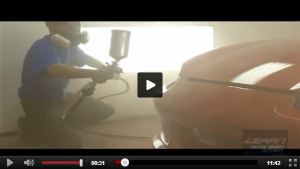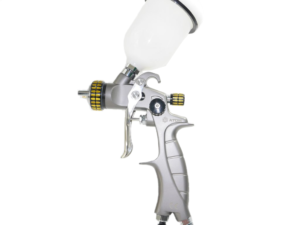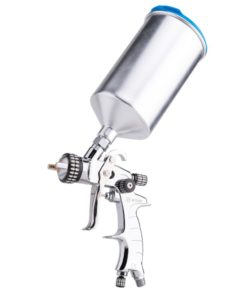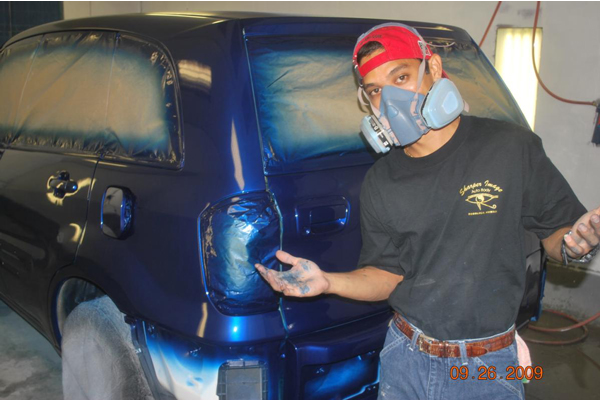HVLP Spray Guns (High Volume Low Pressure) and the number one factor you must consider when purchasing a spray paint gun.
In addition to paint guns, you can purchase air valves that attach to spray guns in-line with their air supply.
The purpose of these valves is to help you fine-tune the air pressure at the gun to perfect your paint spray patterns. We’ll talk more about how to perfect your paint spray pattern a little later.
So what is the number one factor you must consider when purchasing a spray paint gun? Spray Gun Quality.
By being in direct contact with a knowledgeable person who has firsthand experience using the spray gun you are considering buying has some advantages:
You see, product literature may suggest a particular setting for inlet air pressure; while real-world experience can assure you that an alternative inlet air pressure may be necessary.
If you do not have access to this firsthand knowledge, your brand-new spray gun may NEVER operate as well as intended. Inlet air pressure settings are CRITICAL with HVLP spray guns, so it will be worthwhile to ask someone who knows for their recommendations, rather than relying solely on product literature.
Remember, what works and what works best may not be the same.
With conventional spray guns a typical air pressure of 60 psi or more is required. This quite high pressure blasts paint onto the surface with such force that over 65% of the material is lost due to overspray.
Additionally, the high air pressure is more likely to disturb existing dirt and debris and allow it to fall onto fresh paint causing a less than perfect finish.
Like we discussed last week, one viable means of reducing VOC and overspray pollution is by the use of High Volume/Low Pressure (HVLP) spray paint systems.
When HVLP spray paint systems were first introduced, they were composed of a spray paint gun and a turbine system that replaced the conventional air compressor. Although HVLP in theory made sense and was accepted as a working concept, the equipment was less than widely approved.
The new turbine system caused the air blasting the paint onto the vehicle to get too hot, causing the paint to dry too soon, sometimes even before it had landed on the vehicle. Turbine systems have since been redesigned so that they do not get as hot.
A more practical solution was the development of HVLP spray guns that can be used with conventional air compressors. This allows experienced painters to use a system that is more familiar to them and also makes the purchase of an air compressor easier to justify for the novice painter.
In addition, the conventional air compressor is far more versatile than a HVLP turbine paint system.
How HVLP works is by increasing the volume of paint that can uniformly pass through the spray gun’s ports and nozzle, so that a relatively low pressure is all that is needed to propel the paint material out.
The end result is that more paint adheres to auto surfaces and much less is wasted through overspray via paint particles bouncing off surfaces at high pressure.
And the benefits of this?
Well, with the price of paint material alone being at what it is, the purchase of a HVLP spray gun will certainly pay for itself in a couple of repaint jobs, if not the first one.
Not only will you save paint material with a HVLP spray gun, you will see a great reduction in the amount of overspray, which should be of major importance to any part-time auto painter who is working in his/her residential garage or workshop.
It has been recommended for HVLP spray guns to use an air pressure of 10 psi at the tip of the spray gun. This is not to be confused with the air pressure at the inlet of the spray gun where the hose connects. It depends on the design of the spray gun but the inlet pressure may sometimes be near 60 psi to obtain the suggested tip pressure.

Let’s go over the different types of spray paint gun:
SIPHON FEED – A siphon feed gun’s paint cup is mounted below the air nozzle. This design requires more air pressure to siphon the paint material up and out of the cup. With a non-HVLP siphon feed spray gun, approximately 75% of the paint material ends up as overspray.
GRAVITY FEED – A gravity feed spray gun has the paint cup mounted above the air nozzle. This allows gravity to do the work for some of the air pressure, allowing for the use of a lower inlet air pressure.
However, on a non-HVLP spray gun, this will result in approximately 65% of the paint material ending up as overspray.
PRODUCTION GUN – If your painting is going to be limited to large body panels, such as doors, fenders and hoods, a full-size production gun will suit your needs. Commonly having a one-quart paint cup, this gun can spray a fair amount of material before you need to refill.

DETAIL GUN – The difference here is manoeuvrability. Detail guns are perfect for intricate painting jobs, like small touch-ups requiring fine spray patterns and door jamb painting.
A properly adjusted spray gun will give you professional results and will last a very long time if you clean and maintain it correctly.
Now, you are going to have to practice in order to learn how to make proper spray patterns and volume, this is important. Various paint products and their reduction ratios will spray differently, especially with different recommended air pressures, so get hold of an old panel and use it to perfect your skills.
Many painters keep test panels in their spray painting area or they use sheets of wide masking paper taped to a wall, either will provide you with an excellent medium in which to practice and/or test on.
Our advice is to spray paint onto the test panel and then make adjustments to your gun in order to get the right pattern and volume. Never start the actual painting until you are sure you have the correct setting on your paint gun.
Occasionally, during your paint job, you may notice a defect in your gun’s fan pattern. To check it, turn to your test panel and shoot a clean section with a blast of paint. If it doesn’t look right, check the controls and the air pressure.

If the pattern is still flawed disconnect the paint gun from the supply hose and clean it thoroughly. The chances are that a small port or passageway has become clogged and must be cleaned before you can continue spraying paint.
As you move around your vehicle the surfaces that require paint are never the same for long and at times become more confined or difficult to reach, as on some front end sections.
In these instances, you must reduce the air pressure or change the fan spray to hit the smaller areas. You can make these adjustments again by practicing on your test panel.
Finally, holding racks are very useful when painting separate sections of dismantled bodywork. These racks are designed to tilt and adjust for the part that needs to be painted.
They are commonly used in body shops but possibly too much of an investment for the average person painting their first vehicle. If you get lucky enough to find a second-hand rack still in great condition, it could turn out to be a very useful tool to add to your collection.
Check with your auto body paint and supply store; they may be able to point you in the right direction for getting hold of one.
If you can’t get hold of a rack then you could try making your own, failing that make the most out of lying down or hanging up the parts to be painted.
You will need to place them so that you can comfortably access all of the part(s) for painting. This won’t always be possible but do what you can to make your life easier. After you feel you have painted all of the surfaces, take a second look at it from various angles to make sure you haven’t missed anything.
Introducing the new Atom X Series Spray Guns. These are professional spray guns that will give you German and Japanese style, craftsmanship and performance for a fraction of the cost. With a no o-ring design and pure spraying simplicity at its finest. Head on over to Zoolaa and check these awesome spray guns.
It’s Tony from LearnAutoBodyAndPaint. I hope you liked this blog. Talk soon!
-Tony
P.S. If you want to learn more, about auto body and get all the information you need so you can customize your projects, learn how to restore your classic or put a body kit on your car, check out VIP here: LearnAutoBodyAndPaint VIP Course.
Other Helpful Links:
Learn Paint Chip Repair And Auto Scratch Repair Step-By-Step
Master Airbrush Initial Review – Air Brush Spray Gun Review
Automotive Spray Guns – SATA, Iwata, CP, DeVilbiss or a Warwick – Best Bang for Buck?
1 Tip: Adjusting Your Spray Gun – Automotive Spray Gun Setup For Painting Door Jambs

I LOVE YOUR WORK AND I WISH TO WORK WITH YOU
Thank you!
Love your work and your videos just getting into auto paining I do deliveries with Sprinter vans I own a number of them. I’m going to start painting them so I just bought a new sprayer and I’ve been watching your videos thanks so much for your work!
Thanks, Keith! Really appreciate your feedback!
Hey! Check out the Atom Spray Guns on Zoolaa now! Awesome spray guns at a fraction of the cost of the more popular ones! https://www.zoolaa.com/